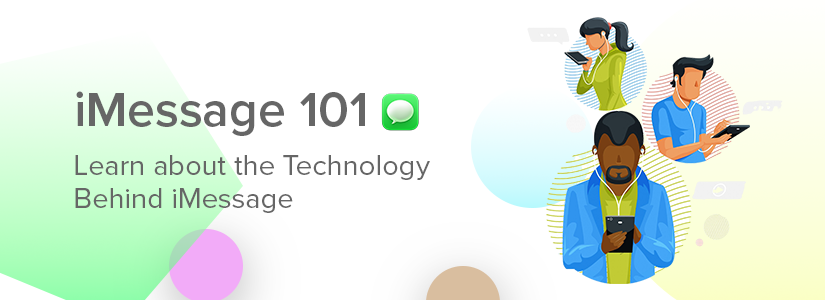iMessage 101: The Technology Behind iMessage

Have you ever wondered how iMessage works behind the scenes? Apple’s iMessage system offers a seamless, secure, and rich communication experience exclusive to its ecosystem, providing users with more than just simple texting. It allows for the sending of multimedia messages, reading receipts, encrypted conversations, and more. From its origins as a revolutionary messaging platform to the cutting-edge technology that powers it today, iMessage has transformed the way people communicate in the digital age.
What makes iMessage unique is its integration with the broader Apple ecosystem, ensuring that whether you’re using an iPhone, iPad, Mac, or Apple Watch, your messages are synced across all your devices. iMessage is not only about convenience but also about providing a secure environment for communication, with end-to-end encryption to protect users’ privacy. To fully appreciate the power of iMessage, it’s important to understand the various technical layers involved, from the design of the service to the encryption protocols that safeguard every message sent.
In this article, we’ll take a closer look at the history, functionality, and innovative technologies that have made iMessage the powerhouse it is today.
History of iMessages
Launched in 2011 alongside iOS 5, iMessage was Apple’s solution to elevate messaging for its users. At the time, its launch was met with enthusiasm, as it introduced a seamless, internet-based alternative to traditional SMS (Short Message Service). Users appreciated its ability to sync across Apple devices, deliver messages faster, and incorporate features like read receipts and media sharing, which were revolutionary in 2011. The goal was to create a feature-rich alternative to traditional SMS that could leverage Apple’s ecosystem for seamless communication.
Since its debut, Apple has continuously enhanced iMessage with features like end-to-end encryption, message effects, reactions, and compatibility across Apple devices. These updates make iMessage not just a communication tool but a platform for dynamic and interactive messaging, setting it apart from competing platforms like WhatsApp, Signal, and Facebook Messenger. While iMessage focuses on exclusivity and integration within the Apple ecosystem, competitors often prioritize cross-platform accessibility and a broader range of customization options, such as chat themes or advanced file-sharing capabilities.
Key Features of iMessage
iMessage stands out from traditional SMS by offering a suite of unique features that significantly enhance the messaging experience:
- Rich Media: One of the standout features that allows the ability for users to share not only text but also photos, videos, GIFs, stickers, and even voice memos. This ability to send multimedia content makes conversations more dynamic and expressive, transforming simple text exchanges into more engaging interactions.
- Read Receipts: Provides users with real-time feedback on their messages. When enabled, it shows when a message has been delivered to the recipient’s device and when it has been read, giving a clearer sense of communication flow. This feature can be particularly useful in both personal and professional settings, allowing users to know if their message has been acknowledged.
- Message Effects: Offers a fun and interactive element. Whether it’s sending a message with balloons floating across the screen for a birthday or a burst of confetti to celebrate a special occasion, these animations provide a playful, personalized touch to messages. Full-screen effects can be used to make messages stand out, ensuring they memorably grab attention.
- Sync Across Devices: Perhaps one of the most convenient aspects of iMessage. iMessage is automatically updated in real-time across each device whether you’re on iPhone, iPad, Mac, or Apple Watch. This ensures that messages are accessible no matter where you are or which Apple device you’re using, providing a unified experience for users who rely on multiple devices throughout the day.
Together, these features are designed to enhance both the convenience and creativity of iMessage, creating a more engaging, interactive, and fluid messaging experience. Whether for personal conversations, professional communication, or sharing moments with friends and family, iMessage makes it easy to stay connected and express yourself in a variety of ways.
Security and Encryption
A standout feature of iMessage is its commitment to robust security, ensuring that users’ messages remain private and protected. Apple has implemented a range of advanced security measures to safeguard the content of conversations, offering peace of mind to its users. This emphasis on security plays a crucial role in maintaining the integrity and confidentiality of personal communication on the platform. These include:
- End-to-End Encryption: iMessage employs end-to-end encryption to ensure that messages are securely transmitted between the sender and recipient. This means that only the intended recipient has the key to decrypt and read the message, providing a high level of privacy. Since its introduction in 2011, this encryption has been a core feature of iMessage, setting a standard for secure communication. By using this technology, iMessage guarantees that sensitive information, whether personal or professional, remains protected from unauthorized access at all times.
- Data Security: iMessage ensures comprehensive protection by encrypting messages both in transit and at rest. “In transit” refers to the encryption process that secures data as it is transmitted between devices, protecting it from interception by unauthorized parties during transmission. On the other hand, “at rest” refers to the encryption of data when it is stored, whether on Apple’s servers or the user’s device. This dual-layered encryption guarantees that messages remain secure, regardless of their location. Even when messages are temporarily stored on Apple’s servers, they are encrypted to the highest standards, with a strict policy of limited retention. Apple’s approach ensures that no unnecessary data is held for longer than needed, further enhancing user privacy.
This strong emphasis on security offers users peace of mind, knowing that their private conversations are safeguarded from unauthorized access. By utilizing advanced encryption techniques and ensuring data protection at every stage, iMessage helps maintain the confidentiality of user communications. As a result, individuals can communicate freely, confident that their messages are shielded from potential threats.
How iMessages Work
1. Message Composition: When you compose and send a message on the iMessage app, the system first checks whether the recipient is using an Apple device. The app performs a quick verification to determine if iMessage is enabled on the recipient’s device. If the recipient is part of the Apple ecosystem, the message is processed through iMessage, ensuring a seamless and efficient communication experience. This feature guarantees that the message will be sent with all the advantages of iMessage, such as multimedia support, encryption, and real-time syncing.
2. Protocol Selection: If the recipient has iMessage enabled, the message is sent over the internet, leveraging Apple’s proprietary messaging system. This ensures that the message benefits from the advanced features of iMessage, including end-to-end encryption, multimedia support, and group messaging capabilities. With iMessage, users can send high-quality images, videos, and voice notes, all while enjoying secure communication that is only accessible to the sender and recipient.
3. Centralized System: iMessages are routed through Apple’s centralized servers, which play a vital role in ensuring the reliability, speed, and security of message delivery. By utilizing this centralized system, Apple can manage the flow of messages, authenticate users, and provide real-time syncing across multiple devices. Apple Push Notification Service (APNs) is instrumental in facilitating this communication, acting as the central server that routes notifications and message data between devices. This system ensures that messages are delivered efficiently, regardless of the device or network the recipient is using, while also enabling features such as read receipts and delivery confirmations.
4. Internet Dependency: An active internet connection, whether through Wi-Fi or cellular data, is necessary to send or receive iMessages. Without an internet connection, the iMessage app cannot route messages via its proprietary system, and communication will be delayed. This dependency on the internet ensures that iMessages can take full advantage of their advanced features, such as real-time message syncing, multimedia sharing, and security protocols like end-to-end encryption. Users can enjoy uninterrupted messaging as long as they have an active internet connection, allowing for smooth communication even across multiple Apple devices.
Editable Messages
With the introduction of iOS 16, Apple significantly enhanced the messaging experience by adding the ability to edit sent messages. This new feature allows users to modify a message within 15 minutes of sending it, offering a valuable level of flexibility when it comes to correcting typos, clarifying statements, or making other adjustments to the message content. When a message is edited, recipients can see that the message has been changed, as a label indicating the edit is visible. This feature gives users greater control over their communication while also ensuring transparency, as recipients are notified of any changes to the original message. By adding this capability, Apple enhances its messaging platform, responding to user demand for flexibility while maintaining the clarity and integrity of interactions.
Centralized vs. Decentralized Networks
- Centralized Network: Apple’s servers are responsible for managing the flow of messages between users, ensuring smooth delivery, enhanced security, and a seamless user experience across all Apple devices. The reliance on Apple’s servers allows for real-time synchronization, end-to-end encryption, and the ability to deliver messages across multiple devices, such as iPhones, iPads, and Macs. By maintaining control over the entire messaging process, Apple can ensure that its services remain stable, secure, and integrated within its ecosystem.
- Decentralized Network: allows messages to travel directly between devices without the need for a central server. This approach can offer more flexibility and often results in fewer points of failure, but it comes at the expense of the centralized control and security that iMessage benefits from. While these systems potentially more open and compatible with a wider variety of devices and platforms, they don’t have the same level of security measures or privacy protection that Apple provides with its centralized model.
Can iMessages Work Without Apple?
The simple answer is no. iMessages are exclusive to Apple’s ecosystem, which means they cannot be sent or received on non-Apple devices. To use iMessage, a user must have an Apple device—such as an iPhone, iPad, or Mac—and an Apple ID. This exclusivity is a strategic aspect of Apple’s ecosystem, allowing for seamless integration and synchronization between various Apple products. While this creates a highly optimized and secure messaging experience for Apple users, it also limits cross-platform accessibility. As a result, iMessages are not compatible with Android, Windows, or other operating systems, which means users outside the Apple ecosystem cannot participate in iMessage conversations. This barrier highlights the advantages of Apple’s closed ecosystem while emphasizing one of its limitations in terms of interoperability with other platforms.
Conclusion
iMessage brings together advanced technology, user-friendly features, and robust security to provide an exceptional messaging experience. By harnessing Apple’s proprietary infrastructure, it seamlessly integrates across all Apple devices, ensuring that users can effortlessly switch between their iPhone, iPad, Mac, and Apple Watch without losing connectivity. The centralized system not only streamlines functionality but also guarantees smoother syncing and real-time communication across devices. With the added strength of end-to-end encryption, iMessage ensures that every message remains private and protected, offering peace of mind for its users. In combining these elements—convenience, security, and seamless integration—iMessage stands out as a modern and reliable communication tool, tailored specifically for the Apple ecosystem.

